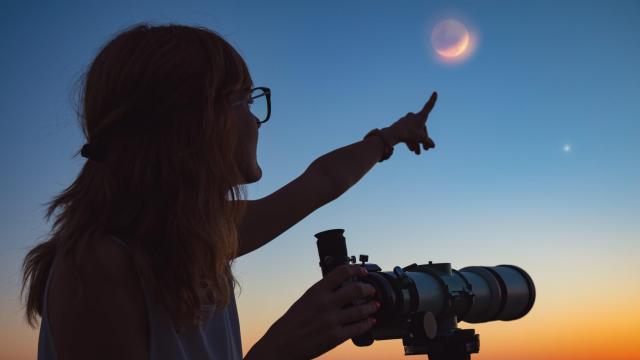The cosmos is in constant motion, and during the month of July, the movements of celestial bodies are an especially welcome treat for those on the ground. The two planets situated on either side of Earth — Mars and Venus — are poised to drift within a relatively close distance of each other, at least in the grand scheme of space.
This planetary conjunction, or “kiss” as it’s colloquially called, will begin in the small hours of Monday morning and continue on through Tuesday. Though it starts early, you won’t have to stay up in the wee hours to catch a glimpse.
What is a conjunction?
It’s simple, really: A conjunction is the passing of two or more celestial bodies. Last month, the moon and Mars aligned in a superior conjunction, which occurs when objects traverse an orbit behind the sun, sometimes rendering them visible to onlookers on the ground. Inferior conjunctions are less exciting, as they involve objects drifting in front of the Sun, which obscures their visibility.
It’s called a “kiss” because it’s a fleeting moment of symmetry. According to the BBC’s Sky at Night, next week’s conjunction is pretty standard fare stargazing:
The most commonly observed conjunctions involve the Moon, often as a crescent in the evening or morning sky, along with any of the bright planets – Venus, Mercury, Mars, Jupiter or Saturn.
Technically, for a true conjunction to occur, two or more celestial bodies need to maintain the same right ascension, or “ecliptic longitude in the sky,” as Sky at Night notes. Not all conjunctions fit the bill in the purest terms, and the one occurring on Monday might be something you call a “conjunction light,” as the moon and Mars won’t technically have the same right ascension, which is the same coordinates measured from east-to-west.
Either way, it should make for some good viewing, especially if you have powerful binoculars or a telescope at the ready.
How to see the conjunction of Mars and Venus
The planets will meet on the evening of July 12. As The Sky Tonight explains, their closest link-up will be around one hour after sunset in the west, north-west.
Mars will appear a bit fainter than Venus, so you might “have to let twilight fade some for you to be able to spot the Red Planet,” Astronomy notes. Your best chance of seeing the planets with any degree of vividness will come with binoculars or a telescope, and a few handy stargazing apps might help your planetary pursuits as well.

Leave a Reply
You must be logged in to post a comment.